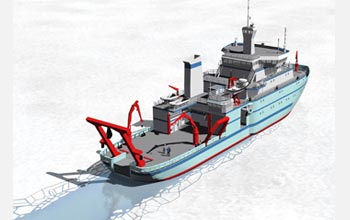News Release 09-108
NSF Announces First Major Award Under American Recovery and Reinvestment Act to the Alaska Region Research Vessel (ARRV)

The Alaska Region Research Vessel will be 242 feet in length.
May 27, 2009
This material is available primarily for archival purposes. Telephone numbers or other contact information may be out of date; please see current contact information at media contacts.
The National Science Foundation (NSF) made its first major award under the American Recovery and Reinvestment Act to construct the Alaska Region Research Vessel (ARRV). This investment will not only provide a technologically advanced tool for science but help preserve jobs and promote economic recovery. The three-year construction phase of the project will support 4,350 total jobs--750 directly at the shipyard and as many as 3,600 in the broader economy. NSF intends to ensure that the ARRV is built in a U.S. shipyard.
The ARRV is a 242-foot research ship that has a hull designed specifically to operate in seasonal Arctic sea ice and open waters surrounding Alaska. Its advanced over-the-side handling systems for science equipment will improve safety and efficiency. The ship is designed for low environmental impact, including reduced underwater radiated noise levels for improved fisheries and acoustics research, as well as lower stack emissions for atmospheric research. The ARRV will carry more than 500 researchers and students annually and spend as many as 300 days per year at sea. It will be operational in support of oceanographic research for at least 30 years.
"We are pleased that our first major award under the Recovery Act will allow NSF to invest in such a large-scale project that will have immediate and long-term benefits to the American economy," said NSF Director Arden L. Bement, Jr. "With rapid changes occurring in the Arctic region, the ARRV will greatly improve our ability to monitor and assess these changes in a timely and safe manner for the benefit of our nation and the world."
Officials with NSF's Office of Polar Programs (OPP) are also pleased about the development and deployment of the ARRV. Currently OPP faces a choice when supporting research conducted on vessels in the current academic research fleet: use non-ice strengthened ships in ice-free waters only, or use U.S. Coast Guard icebreakers specifically designed for an icebreaking mission but not necessarily optimized for research. The ARRV will allow researchers to work in moderate ice-covered waters on a vessel specifically built for research. Dual-ship missions with the U.S. Coast Guard icebreakers will open even more science opportunities for work in heavier ice. This means the ARRV will play an essential role in understanding the Arctic ocean system and how it is changing.
Examples of ARRV's research expeditions include furthering our understanding of sea ice recession, changing ocean currents and Arctic habitats and ocean acidification. Changing Arctic climate may be a critical driver for climate change over the entire planet. In addition, the Gulf of Alaska and Aleutian islands are subject to major seismic events that require further study, including extensive seafloor mapping.
NSF issued a solicitation for construction and operation of ARRV in November 2006. In 2007, the University of Alaska, Fairbanks was selected to lead this effort, including all tests and science trials. The U.S. academic fleet of research vessels includes 22 vessels of various sizes. The addition of ARRV represents a major contribution to the legacy of the International Polar Year, advancement of U.S. Arctic policy, and a stronger understanding of our global climate and ecosystems. Delivery of the vessel is anticipated for 2013 with science operations beginning in 2014.
-NSF-
-
Artist's rendition of the Alaska Region Research Vessel.
Credit and Larger Version
Media Contacts
Dana Topousis, National Science Foundation, (703) 292-7750, email: dtopousi@nsf.gov
Program Contacts
Matthew Hawkins, National Science Foundation, (703) 292-7407, email: mjhawkin@nsf.gov
Simon Stephenson, National Science Foundation, (703) 292-7435, email: sstephen@nsf.gov
The U.S. National Science Foundation propels the nation forward by advancing fundamental research in all fields of science and engineering. NSF supports research and people by providing facilities, instruments and funding to support their ingenuity and sustain the U.S. as a global leader in research and innovation. With a fiscal year 2023 budget of $9.5 billion, NSF funds reach all 50 states through grants to nearly 2,000 colleges, universities and institutions. Each year, NSF receives more than 40,000 competitive proposals and makes about 11,000 new awards. Those awards include support for cooperative research with industry, Arctic and Antarctic research and operations, and U.S. participation in international scientific efforts.
Connect with us online
NSF website: nsf.gov
NSF News: nsf.gov/news
For News Media: nsf.gov/news/newsroom
Statistics: nsf.gov/statistics/
Awards database: nsf.gov/awardsearch/
Follow us on social
Twitter: twitter.com/NSF
Facebook: facebook.com/US.NSF
Instagram: instagram.com/nsfgov

